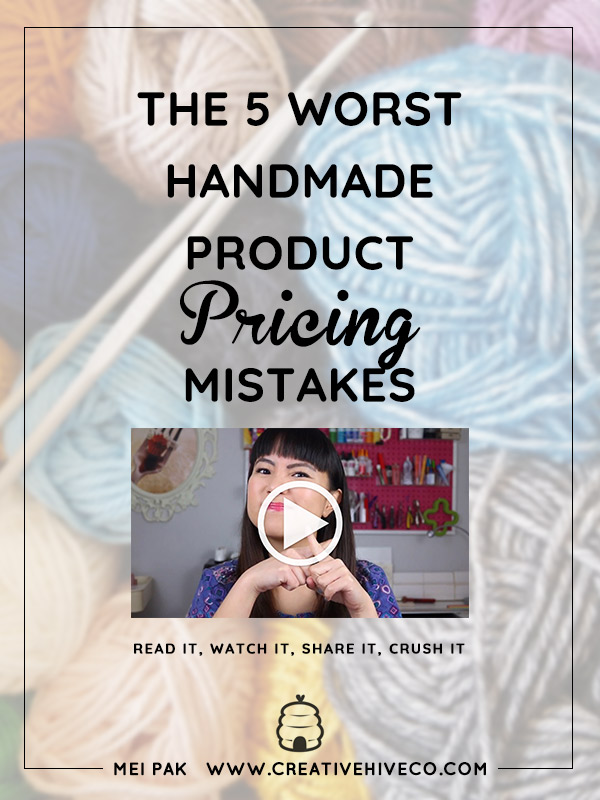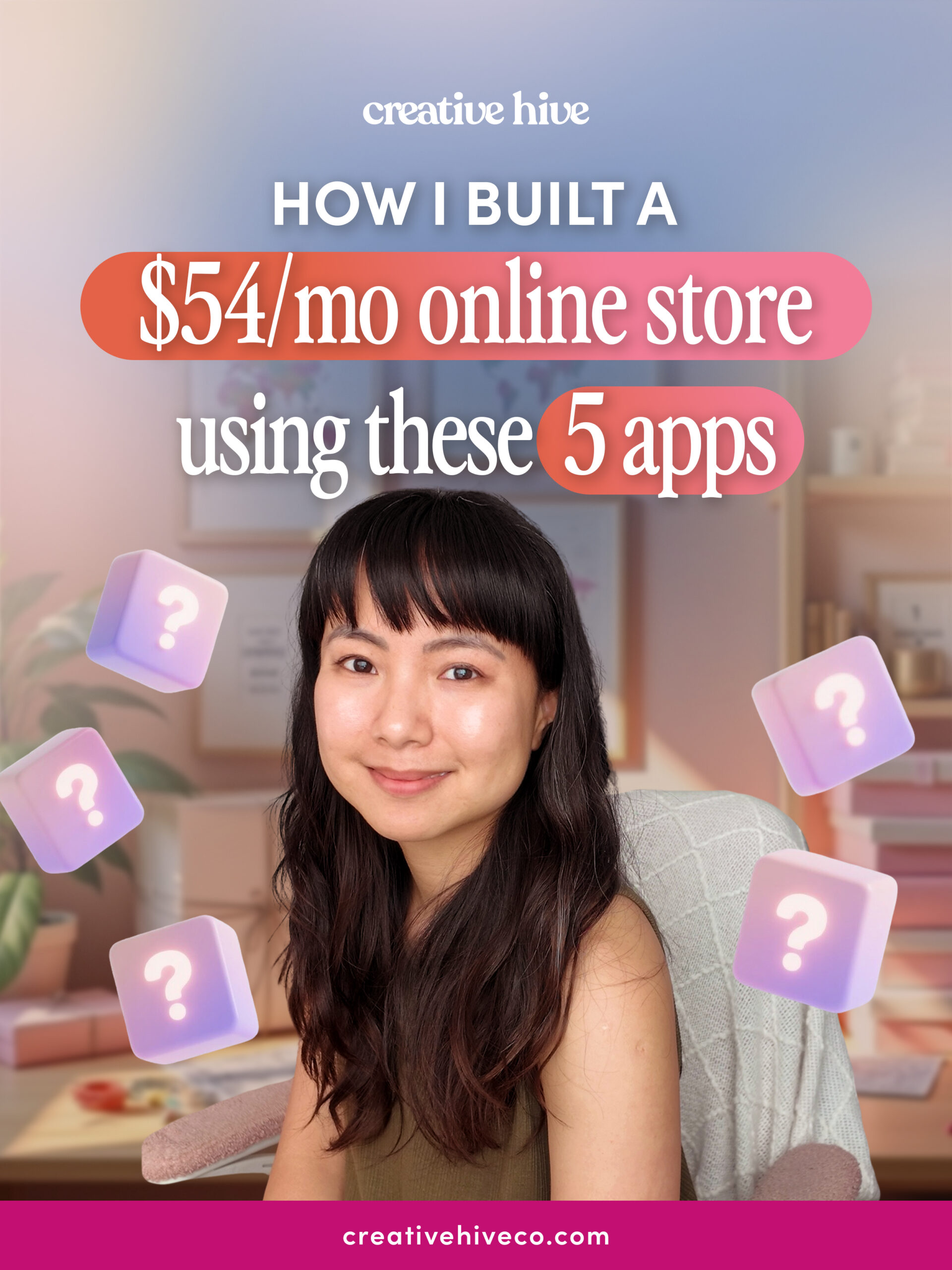I want to help you build a sustainable, profitable handmade business that makes you consistent income and sales. I only ever teach or recommend marketing, social media, pricing, production and branding tips that I’ve personally used successfully in my own 7-figure handmade businesses.
I'm Mei, from Los Angeles!
Read More
Popular Posts You'll Love
Looking for something?
Categories
starting a business
get more traffic
running a business
make more sales
branding
growing a business
mindset & productivity
podcasts
pricing & money
product photography
reviews
selling on etsy
selling on amazon
social media
selling wholesale
- Facebook0
- Twitter0
- Pinterest14
- 14shares
You’re probably making at least one of these five handmade product pricing mistakes that can cost you sales, attract the wrong customers, and even cause you to go out of business.
Keep reading so you can fix your product pricing and avoid all of that from happening.
1. You Don’t Use the Pricing Formula
The first mistake is that you’re not using a pricing formula.
I believe every product price needs to follow a two-step process. The first step is you need to use a formula.
My formula is taking your materials cost, add your time spent making your products, then multiply by two.
That result is your wholesale price.
Then take your wholesale price and multiply by two again to get to your retail price.
Even if you never sell wholesale, it’s good to know what that number is. What that does is it adds an extra layer of profit for your business that keeps you sustainable. Sustainable means, paying you the right amount of money for every sale you make so that you stay in business longer.
That’s the goal. You don’t want to sell your products and just go out of business a few months later. You want to stay in this for the long term.
If you need more information about that formula, go and watch my video talking about it.
Your product price needs to start with a formula, and then once you have a number, the second step is tweaking it to account for the more artistic side of pricing like considering the value your product gives to your customers and where you want to position yourself in your market or niche and among your competitors.
Your product pricing tells a story about what your product is like.
If you want to learn more about that, I have another video talking more about the art of pricing that you might not be considering.
At the start of it, pricing starts with a formula. If you don’t start with that, you’re not going to have a number that properly accounts for your costs, time spent making your product, your other business expenses, or your business profit.
You also won’t have a number that will sustain you or your business.
Even if you never end up using the number for your price that the formula gives you, it’s a good starting point. Don’t use just gut or intuition in the beginning.
Start with facts first.
Definitely don’t just go and price your product at the same price (or a lower price) than what other people are doing with similar products.
It’s like comparing apples to oranges.
Your competitors and other shops selling similar products as you aren’t getting their supplies and materials from the same shops as you. They don’t have the same process as you. You take a different amount of time to make your products than they do.

2. You’re Not Marking Up Your Product Prices ENOUGH
The second mistake I see people make is not marking up their product prices enough.
So, I just talked about my pricing formula. Remember how we took materials cost and labor, multiplied that by two to get wholesale. Then took that wholesale number and multiplied that by two again, to get your retail price. We multiplied by two twice.
In other words, to simplify that, we’re taking materials cost and labor and multiplying that by FOUR.
Let’s use an example.
Say you make jewelry and your material costs are $10 and it took you 1 hour to make a necklace and you decided your hourly rate to make products is $20. That’s $30 total cost, that you then multiply by four to get to $120 retail price.
That is the price you charge your end customer.
That might sound like it’s too much, but this is healthy pricing.
The mistake I see many people make is just marking up their products by two, which in this case, means selling your necklace for $60.
When you don’t markup your prices enough, it sets your business up to struggle.
There are a few reasons why I encourage marking up by at least four times.
1. It Takes a Lot of Money to Run Your Business
I get that you want to charge less for your products because you think that means you’ll make more sales, but that’s not necessarily true.
Customers have learned to subconsciously equate lower prices with lesser quality and they’re less likely to buy. So you need healthy profits coming in from every sale to keep your business running.
2. It Costs Money to Make Sales
If it’s not money in terms of your time spent promoting on social media or reaching out to magazines or influencers, it’s money in terms of cash money where you’re spending on ads to acquire a customer.
There is no such thing as a free sale. You had to work for that sale, and you can’t afford to not be paid for that time.
3. If You Don’t Mark Up Enough, It’s Not Sustainable for Your Business
Like I said before, we didn’t just start a business only to let it die a few months later.
Many of us who go into business for ourselves are doing it for the long term. A lot of us have a goal or dream to quit our jobs and have our businesses support us financially completely.
If you want to get to that point you MUST mark your prices up accordingly because it costs money to make sales and it’s expensive to run a business.
You will get burned out or go bust really quickly when your prices aren’t marked up by at least that four times.
3. You’re Not Pricing Your Products Appropriately
When you get this, it will open up a whole new perspective on your product pricing that you may not even be aware of, and you might actually be able to keep your prices a bit lower.
I know you might be thinking, that I just said to price your products high and now I’m saying to price your products low.
But, it’s a balance right?
Ultimately, you want to price your products appropriately. That means, not too high, but high enough to pay you, your business, and to sustain it in the long term.
You want it to be low enough that you’re not turning away most customers who want to buy from you, but not too low that you start looking like a discount shop.
When you think about my formula, as long as you are the person in your business making your products and you haven’t hired it out to someone else, you actually get paid twice.
The first time you get paid is as a tradesman for your time to make your product. That’s the first part of the formula when we took materials cost plus your labor, which is your time spent making that item.
The second time you get paid, is as a business owner, through your profits, when we multiplied your costs and time by four.
Taking our previous example. You got paid $20 for your time spent as a tradesman. Then you got paid $90 in profits as a business owner.
Of course, since it all goes into the same pocket, your pocket, you can total that up, and you’ve got $110 that you made from selling a $120 necklace, where your materials cost $10.
The mistake people make is thinking they only get paid once as a tradesman.
So when they hear they’re only getting paid $20 for that sale, it doesn’t sound right. The instinct is for people to increase that hourly rate to something like $30.
The problem with that is when you use the formula, now your product retail price is $160. That’s $40 more than when you set your hourly rate to $20.
The motivation lies in wanting to get paid a decent hourly rate because you have years of experience with your craft, you’re good at doing it, and no one else can do what you do.
I agree with all of that. You should get paid well for your products.
The mistake is in thinking that you only get paid once.
In reality, you get paid a lot more and a big chunk of your pay comes from the profits, not from your wage as a tradesman.
You are a business owner now, not just a crafter.
My recommendation is to lower your hourly rate so that you can, in effect, lower your retail price.
Let’s say we used $10 as your hourly labor rate, that’s $20 cost to make your necklace, multiply that by four, and now you’ve got a retail price of $80.
It’s a lot more affordable than a $120 or $160, but it’s not too cheap.
It puts you in a sweet spot for both your customer and you because you’re still getting paid a total of $70 when you sell that necklace.

4. You Think Cheaper Pricing Equal More Sales
This is not true.
Across the board in all my businesses, when I started them out I always priced really low at first because I didn’t have confidence in my products or services.
It’s not because they weren’t any good but because I didn’t realize that other people valued what I created.
I talk about this in my A Sale A Day course, but your product pricing is SO tied to your confidence.
My businesses did not make more sales during the time I priced my stuff for less.
In fact when I increased prices, not only did I start making more sales, but I was more profitable and I had more money in my pocket, which made it easier for me to get more sales.
Remember I said before, it costs money to make money. It costs time or money to make sales. Sales aren’t free.
I also was able to attract better customers that I love working with and who respected me. The maker-client relationship is so much more positive and healthier than when I was serving customers who only bought from me because I was the cheaper option.
There’s no loyalty in that. There’s no relationship.
I have a challenge for you today. After you read this post, you should have a better sense for how to price your products better. It’s likely you’ll have to increase your prices because most people find they don’t charge enough. It’s going to be scary, but I want you to increase your prices.
You may not see an instant increase in sales, because all this time, you’ve been attracting an audience that expected a certain, lower price point from you, but over time, you’ll see that you’ll make more money and you’ll be more profitable in the long run.

5. You’re Using Costs Alone as a Basis for Pricing
This goes back to the first mistake. There are two steps to pricing your products. The first step is following a formula, which is essentially using costs as a basis for pricing.
The mistake people make is even if they follow a formula, they aren’t doing the second step which is accounting for the value your products give to your customers, the position you want to put yourself in your market, and whether your products are in high demand and low in supply.
These are other factors that can influence the lowering or increasing of your price.
If you have customers that really value and love your products then you can afford to increase your prices to reflect how much your products help them and the value it gives them.
Or maybe you decide you want to be priced super affordably because you want to be competitive in the market then you can lower your prices a bit.
If you’re the only one in your market doing what you do and you’re so overwhelmed with orders that you can’t keep up, that’s a good time to raise prices.
There’s nothing wrong with that.
Increasing or lowering your prices are both legit strategies that can work really well depending on your goals.
Don’t make the mistake of pricing your products just based on the numeric materials cost and time spent to make your products.

Leave a Comment
Liked this article? Share it!
Unlock a Profitable Handmade Business
in Just 12 Weeks Without Using Etsy
or Social Media
FREE WORKSHOP
This workshop is for anyone who makes and sells a handmade or physical product, including jewelry designers, artists, paper designers, bath & body product makers and more!
What You'll Discover
The #1 mistake people make with Etsy & social media that causes shops to FLOP
The secret to making it with your handmade shop so it's no longer just a hobby
How to make sales in your handmade shop with ease so you can finally get to 6-figures
TAKE ME THERE
Your email address will not be published. Required fields are marked *
Leave a Reply Cancel reply
About
Blog
A Sale A Day
Student Login
Free Class
Contact
Terms
Become A Student
Watch On YouTube
Student Reviews
See My Handmade Shop!



Hello,may I have skme tips from you , how to start a handmade business for a teenager like me?Thanks for your advice about pricing..
Crafting handmade products is an art, but pricing them right requires strategy. Here are five common pricing mistakes to avoid: undervaluing your work, disregarding costs, failing to consider market demand, ignoring competitor prices, and inflexible pricing.
Thankfully, Priceva offers a solution: Competitor Price Tracking & Monitoring software. With automated tracking and price change notifications, it keeps you informed. Manage all pricing metrics through a single interface, and uncover market opportunities with comprehensive analytics. Leveraging AI-based repricing tools, Priceva helps create a perfect pricing strategy for you. To enhance your handmade business, explore the advantages of Priceva at https://priceva.com/. Avoid costly mistakes and seize your market share!